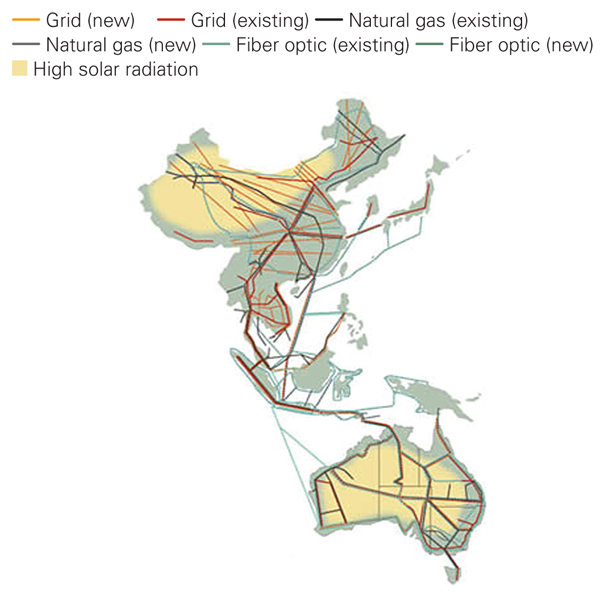
Desertec Ambitions Turn to Asia, Australia
Mar 7, 2012 - Sonal Patel - powermag.com
The ambitious Desertec project—a $9 billion initiative to develop, harness, and transmit 2,000 MW of renewable power from North Africa and the Middle East to Europe by 2050—has been trumped by a vaster concept that spans Asia and Australia (Figure 8).
 |
| 8. Looking skyward. Inspired by the Desertec project, which envisions that 15% of Europe’s power could be sourced from renewable projects in North Africa and the Middle East by 2050, the Grenatec project calls for infrastructure links between China, Southeast Asia, and Australia that will enable those regions to share power, natural gas, and information via fiber optic channels. Courtesy: Grenatec |
Founded by Stewart Taggart, a former journalist and a founder of Desertec, Grenatec, a so-called “Pan-Asian Energy ‘Internet,’” calls for infrastructure links between China, Southeast Asia, and Australia by 2050 that will enable those regions to share power, natural gas resources, and information via fiber optic channels.
“Deepened cross-border electricity and natural gas interconnections increase market efficiency and reduce transport friction,” Grenatec says in a recent 230-page report. “This shouldn’t be hard. Common standards are widespread.” Grenatec argues that China, Japan, South Korea, Australia, and Southeast Asian states will collectively spend trillions of dollars in updating their infrastructure. The Association of Southeast Asian Nations (ASEAN), for example, is developing the Trans-ASEAN Gas Pipeline and Trans-ASEAN Electricity Grid to enhance integration among the organization’s 10 members, while China plans for a unified domestic power grid by 2020 using high-voltage transmission links.
Several hurdles will need to be overcome, Grenatec admits. One incentive that could encourage multilateral cooperation is to introduce carbon pricing that could “rearrange the ‘dispatch order’ of regional electricity-generation in favor of low-emission energy sources.” Costs are another, but, if Asia plans ahead and coordinates investment, “these costs (as well as the costs of climate change) can be much reduced,” it claims.
Grenatec’s plans stem from Desertec ambitions to source 15% of Europe’s power from North Africa and the Middle East by 2050. The initiative formed in 2009—which includes heavyweights such as ABB, Abengoa Solar, Cevital, Deutsche Bank, EON, HSH Nordbank, Muenchener Rueca, M+W Zander, RWE, Schott Solar, and Siemens—has quietly been making strides. Last November, Desertec contracted the 500-MW Ouarzazate concentrating solar power plant in Morocco, the first of five planned to come online between 2015 and 2020. That project has since received $297 million in loans from the World Bank.
Early in January, the Desertec Industrial Initiative said it had signed an agreement to develop a mammoth 22,000 MW of renewable power by 2030 with Algerian energy company Sonelgaz—stipulating that half that power would be exported to Europe. And at the end of January, the initiative announced construction of the 2,000-MW TuNur concentrating solar plant in Tunisia, a project that would begin exporting power to Europe by 2016 via a new low-loss transmission line to Italy.

|